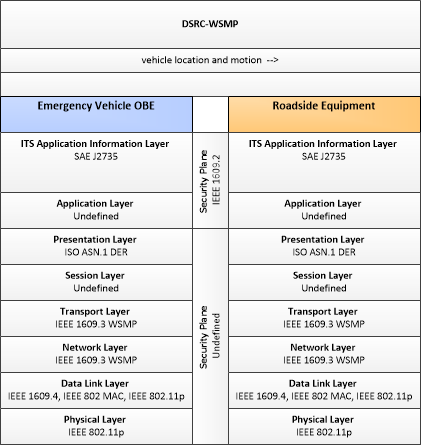Link Type: Short Range Wireless
Emergency Vehicle OBE --> Roadside Equipment:
vehicle location and motion
Definitions
vehicle location and motion (Information Flow): Data describing the vehicle's location in three dimensions, heading, speed, acceleration, braking status, and size.
Emergency Vehicle OBE (Source Physical Object): The Emergency Vehicle On-Board Equipment (OBE) resides in an emergency vehicle and provides the processing, storage, and communications functions that support public safety-related connected vehicle applications. It represents a range of vehicles including those operated by police, fire, and emergency medical services. In addition, it represents other incident response vehicles including towing and recovery vehicles and freeway service patrols. It includes two-way communications to support coordinated response to emergencies. In CVRIA, a separate 'Vehicle OBE' physical object supports the general V2V and V2I safety applications and other applications that apply to all vehicles, including emergency vehicles. The Emergency Vehicle OBE supplements these general capabilities with capabilities that are specific to emergency vehicles.
Roadside Equipment (Destination Physical Object): 'Roadside Equipment' (RSE) represents the Connected Vehicle roadside devices that are used to send messages to, and receive messages from, nearby vehicles using Dedicated Short Range Communications (DSRC) or other alternative wireless communications technologies. Communications with adjacent field equipment and back office centers that monitor and control the RSE are also supported. This device operates from a fixed position and may be permanently deployed or a portable device that is located temporarily in the vicinity of a traffic incident, road construction, or a special event. It includes a processor, data storage, and communications capabilities that support secure communications with passing vehicles, other field equipment, and centers.
Included In
This Information Flow is in the following Applications:
This Information Flow is in the following Application Objects:
Communication Diagrams
The communication diagram(s) can be viewed in SVG or PNG format and the current format is SVG. Switch to PNG format.
Characteristics
Architectural:
| Characteristic | Value |
|---|---|
| Time Context | Now |
| Spatial Context | Adjacent |
| Acknowledgement | False |
| Cardinality | Broadcast |
| Initiator | Source |
Security
This information flow triple is in the following applications with the following security levels.
| Information Flow Security | |||||
|---|---|---|---|---|---|
| Application | Confidentiality | Integrity | Availability | ||
| Basis | Basis | Basis | |||
| Emergency Vehicle Preemption | Low | Moderate | Moderate | ||
| The location and motion information can be directly observable by monitoring the intersection. As such there is no issue with this being accessible by everyone in the area. | Incorrect information could lead to the system not operating properly. If the system does not properly know where the emergency vehicle is coming from and where it is heading, the system could incorrectly route traffic in an attempt to speed up the emergency vehicle. If it is making logic decisions based on incorrect data, this could prevent the emergency vehicle from navigating through the intersection quickly. | This data is required for the Emergency Vehicle Preemption to operate properly. If this data is not available, the emergency vehicle may not be able to travel through the intersection quickly enough. If an emergency vehicle is not able to get through the intersection quickly enough, it could prevent them from responding to the emergency in a timely manner. As discussed above, the difference between success and failure of this application is not catastrophic, but it is significant, so a moderate availability rating seems appropriate. | |||
